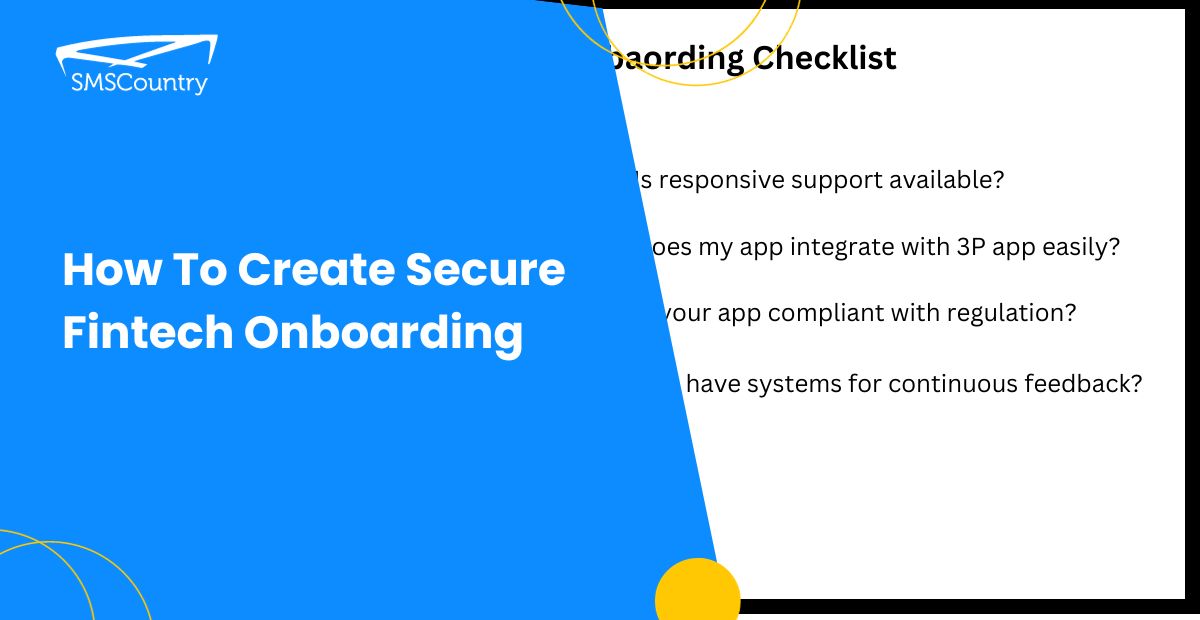Are you in the fintech industry? Do you want to improve your client onboarding while ensuring security?
This article will teach you how to secure your fintech client onboarding. You’ll also learn to safeguard your clients and business from threats.
Let’s dive in.
What is customer onboarding?
Customer onboarding is integrating your new customers into a business or service.
Let’s say you win a new customer. What do you do next? You make them feel welcomed, just like you would do to your guests.
You take them through all the necessary steps to get started with using your application. Provide them with helpful tutorials. And send them notifications about new features and exclusive offers.
Everything you do to help new customers start using your software is onboarding.
See a user onboarding flow below.

Source: uxcam.com
Why is fintech client onboarding so important?
Here’s why onboarding holds the key to your customer experience with your product and the success of your business:
- Building trust from the start: In the financial world, trust is everything. A seamless onboarding shows customers you prioritise their security and privacy. It establishes a strong, trustworthy relationship from the start.
- Reduces confusion: A customer signs up for your app. He gets lost in a maze of confusing steps. Effective onboarding eliminates confusion. It makes it easier for users to navigate your app. This increases their likelihood of adopting and sticking with your service.
- Empowers users’ knowledge: Financial tools like yours can be complex. Onboarding provides an opportunity to educate your users and guide them through the functionalities of your app. This way, you empower them to make the most of your solution.
- Promotes customer loyalty: The fintech world is delicate, and customer loyalty is gold. A well-executed onboarding process increases customer satisfaction, reduces churn rates, and boosts customer lifetime value.
Now you know why customer onboarding is important for your financial services to shine.
What are the onboarding challenges and risks in finance?
As you know, the world of finance comes with its challenges. Knowing these obstacles helps you navigate a successful onboarding.
So, let’s dive into some common challenges and risks of financial client onboarding.
- Regulatory compliance: Financial regulations can be difficult to navigate. And they change every time. If you’re not always updated on the financial regulations you need to comply with in your onboarding, your business and customers may be at risk.
- Complex identity verification: Verifying customer identities and ensuring a convenient user experience is hard. So, you need a middle ground that ensures security without overwhelming the user.
- Education of users on complex concepts: Introducing users to complex financial concepts can be difficult.
- Fraud and financial crime: Because, as a financial business, you’re an attractive target for fraudsters and cybercriminals, you have to invest more resources to protect your users right from onboarding.
How to onboard your finance customers easily and securely
Want to onboard your finance customer smoothly and securely?
Follow these 5 tips for a successful onboarding process and leave your customers smiling.
1. Simplified registration and account setup
Keep the registration and account setup process simple. Don’t overwhelm your customers with a bunch of unnecessary steps or information.
The easier it is for them to sign up, the more likely they will stay.
Also, a simple registration process sets the foundation for a positive onboarding experience.
2. Strong security measures implementation
Prioritise implementing strong security measures. This will protect your customers’ sensitive information.
This includes two-factor authentication, secure encryption, and regular security audits.
So, commit to safeguarding their data and building trust and confidence.
3. Show them the way with clear guidance
For example, Binance shows the user the inside of the app before they sign up.

Source: uxcam.com
Want a successful financial client onboarding? Then, guide your customers through your platform.
Provide clear and intuitive instructions, along with interactive tutorials. This will help them navigate your services with ease.
This clear guidance will empower your customers to maximise your platform’s features. It will also help you ensure a positive user experience.
4. Personalise the experience
Give your customers a personalised touch. Use their data to offer tailored recommendations.
Show them that you know what they need and want. This will make them want to have a personal finance assistant.
5. Stay connected with ongoing support
While onboarding your customers, keep the love flowing with ongoing support and communication.
Be there for your customers when they have questions or need assistance. Provide them with helpful resources and keep them in the loop with updates and cool stuff.
It’s all about building a lasting relationship.
What are the key components of a successful digital onboarding process?
Do you want to ensure you provide your clients with a seamless experience? Then you must hit all the right notes.
Here are some best practices for successful financial client onboarding:
- Streamlined registration: Keep it quick and simple for clients to sign up. This enhances the onboarding experience. Get clients up and running in no time.
- User-friendly interface: Design your onboarding process with a user-friendly interface. Make it intuitive, easy to navigate, and visually appealing. A user-friendly interface ensures clients feel comfortable and confident while exploring your platform.
- Personalisation: Tailor the onboarding journey to each client’s needs. Use personalised messages, recommended actions, or customised paths. It boosts your onboarding experience.
- Educational resources: Provide clear and accessible educational resources. And guide clients through your platform’s features and functionalities. This helps them understand how to maximise your product or service.
- Proactive communication: Keep the lines of communication open with a timely and proactive outreach. Send welcome emails and SMS, provide status updates, or offer assistance when needed. Proactive communication reassures clients that you’re there for them every step of the way.
- Responsive support: Offer responsive customer support during the onboarding process. Promptly address client inquiries, concerns, or issues. Responsive support builds trust and confidence. This ensures clients feel supported throughout their onboarding journey.
- Clear milestones and progress tracking: Clearly define milestones and provide clients with a sense of progress as they advance through onboarding. This creates a feeling of accomplishment and motivates them to continue exploring and using your platform.
- Seamless integration: If your platform integrates with other services or applications, ensure a seamless integration experience for your clients. This saves them time and effort.
Your ultimate fintech customer onboarding checklist

You want to ensure a smooth and successful onboarding process.
And to help you cover all the essentials, here’s a handy checklist to guide you:
Is the registration simplified? Make the registration process quick and straightforward for your customers. It minimises the required information and steps.
Is strong data security in place? Implement robust security measures. This includes two-factor authentication, encryption, and regular security audits.
Is there clear user guidance? Provide clear instructions and user-friendly tutorials. And guide customers through your fintech platform.
Is the onboarding personalised? Tailor the onboarding experience to each customer’s needs and preferences. And provide personalised recommendation options.
Are there self-help educational resources? Offer easily accessible educational resources like videos or knowledge bases to help users make the most of your app.
Is responsive support available? Be responsive and provide excellent customer support during onboarding.
Does my app integrate with 3P apps easily? Ensure seamless integration with third-party (3P) systems.
Is your app compliant with regulations? Adhere to regulatory requirements and compliance standards. This will maintain the trust and confidence of your customers.
Do I have systems for continuous feedback? Gather customer feedback throughout the onboarding process. And use it to drive continuous improvement for your app.
Why most fintech businesses use SMS to secure onboarding
How can SMS be used in the onboarding process?
One common approach is to send a one-time verification code. This adds an extra layer of security.
This also ensures the account creator is the legitimate phone number owner.
When you use SMS for identity verification, you can significantly reduce the risk of fraudulent account creation.
Let’s outline the benefits of using SMS for securing your onboarding.
Firstly, SMS verification provides a real-time authentication process. It avoids the need for lengthy manual identity verification procedures. This streamlines the onboarding experience and minimises customer frustration.
Secondly, SMS verification offers a high level of security.
How? Because it utilises the customers’ mobile phones — which are usually personal and secure devices.
This helps safeguard sensitive customer information and reduce the risk of account takeovers and identity theft.
This is how SMS enhances security, protects customer data, and builds a solid foundation of trust with clients.
Secure fintech client onboarding with SMSCountry
And that’s a wrap.
Now you’ve got the lowdown on secure fintech onboarding. And how SMS can be your trusty sidekick in protecting client data.
To set up OTP two-factor authentication for your app, look no further than SMSCountry.
It is the go-to platform trusted by many to ensure seamless OTP delivery for your users.
Want to see how it works? Schedule a free demo with us today. And we’d work you through how to set up secure onboarding with OTP 2FA.




